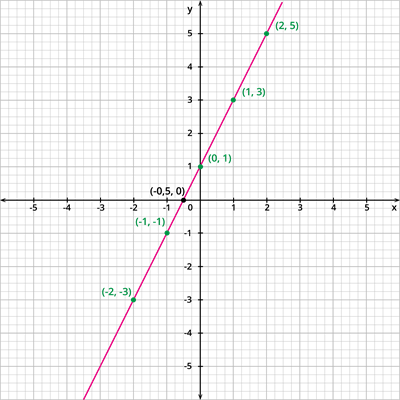UPSKILL MATH PLUS
Learn Mathematics through our AI based learning portal with the support of our Academic Experts!
Learn moreA polynomial of the form ax + b, a \neq 0 is a linear polynomial.
The graph of a linear polynomial is a straight line.
Consider the graph of y = 2x + 1.
x | -2 | -1 | 0 | 1 | 2 |
2x + 1 | 2(-2) + 1 = - 4 + 1 = -3 | 2(-1) + 1 = - 2 + 1 = -1 | 2(0) + 1 = 0 + 1 = 1 | 2(1) + 1 = 2 + 1 = 3 | 2(2) + 1 = 4 + 1 = 5 |
y = 2x + 1 | -3 | -1 | 1 | 3 | 5 |
Join the coordinates (-2, -3), (-1, -1), (0, 1), (1, 3) and (2, 5) by a straight line so as to obtain the graph of y = 2x + 1.
 |
It is observed that, the graph of the polynomial y = 2x + 1 intersects the x - axis at the point (- 0.5, 1).
Also by the definition, the zero of y = 2x + 1 is given by x = \frac{-1}{2} = -0.5.
Thus, we can say that the zero of a linear polynomial is the x - coordinate of the point where the graph of the polynomial intersects the x - axis.
In general, for a linear polynomial ax + b, a \neq 0, the graph of y = ax + b represents a straight line which intersects the x - axis exactly at the point \left(\frac{-b}{a}, 0\right).
The linear polynomial ax + b, a \neq 0, has exactly one zero namely \frac{-b}{a} which is the x - coordinate of the point where the graph of the polynomial intersects the x - axis.